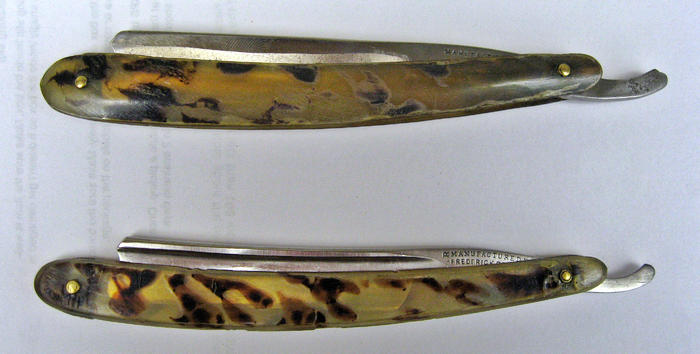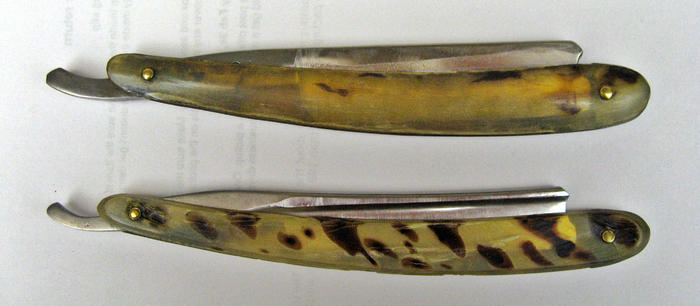Results 1 to 10 of 13
Thread: How to Polish Pinned Scales
-
09-30-2020, 01:16 AM #1I'm a social vegan. I avoid meet.



- Join Date
- Nov 2006
- Location
- Greenacres, FL
- Posts
- 3,226
Thanked: 603 How to Polish Pinned Scales
How to Polish Pinned Scales
A pair (unmatched) of straight razors with dyed-horn scales in need of TLC. They spent a few weeks immersed in linseed neatsfoot oil, then drained and dried. They look much better, but I'm sure that more work would make them look even better. Unfortunately, they're still pinned to the blades, and my arthritic hands and fingers are no longer capable of unpinning/repinning them.
So, what's up with polishing the scales in their present configuration? I have a wide range of sandpapers (through 3,000 grit) and micromesh pads (through 12,000 grit). Go? No-go? What else? Don't be shy.
In each photo: (top) Henry Sears & Son, (bottom) Fredrick Reynolds


Last edited by JBHoren; 09-30-2020 at 01:17 PM.
You can have everything, and still not have enough.
I'd give it all up, for just a little more.
-
09-30-2020, 02:38 AM #2

I don't know the answer, but I am interested in what the experts will say.
Semper Fi !
John
-
09-30-2020, 04:07 AM #3

Horn will certainly polish up with progressive grits of sandpaper & micromesh to a mirror finish.
Problem is you have a live blade floating around in the work area & the pins will prevent you from getting a neat job as they'll obstruct your strokes.
You can wrap the blade in electrical tape but not sure how to deal with the pins.
It's a job you could do with the right wheels & compounds on a buffer & I reckon if you have arthritis hand sanding will be a pita.
A lot of the old horn scales were left raw. You could even feel the growth lines. Maybe the simplest thing would be some car polish or wax ?The white gleam of swords, not the black ink of books, clears doubts and uncertainties and bleak outlooks.
-
09-30-2020, 05:09 AM #4Senior Member




- Join Date
- Feb 2013
- Location
- Haida Gwaii, British Columbia, Canada
- Posts
- 14,451
Thanked: 4829
Personally, I like the satin finish on those old scales. Typically if they were bite free, I would soak them in neatsfoot oil and then give them a careful going over with 0000 steel wool, a little beats foot on the steel wool will leave them with a nice satin glow and the steel wool will also brighten up the pins and collars. Likely you’ll be able to get very nicely around the collars. I’m not sure how your hands will like it, but you can do it in little doses. I understand exercising your finger in small doses is suppose to help your arthritis. They don’t look bad at all so it should take much.
It's not what you know, it's who you take fishing!
-
The Following User Says Thank You to RezDog For This Useful Post:
JBHoren (09-30-2020)
-
09-30-2020, 10:46 AM #5

The pins are the problem. They will cause a discontinuity.
Unpin and use a buffer with white compound. You must go slowly to prevent heat damage.
If pinning is not to be then use micro mesh and get as close to the pins as you can.If you don't care where you are, you are not lost.
-
09-30-2020, 01:46 PM #6

With all the horn scales I've restored, I'm with Rez. I always finish with steel wool, then polish by hand with Flitz or Maas.
I don't have arthritis, but do have trouble with a lot of my joints in my body. My legs are affected by lower spinal stenosis, my arms and hands, from damage to the nerves in my cervix. C-6 & C-7
If I don't keep moving, I get all locked up, and stiff.
I feel for those that have bad arthritis, there's days I can barely puck up a cup of coffee, without it sending excruciating pain through my hands and fingers.
But once I get passed that, and get active enough, its tolerated. Been dealing with it since my late 20s, I'm in my early 50s now.
Who ever called it the golden years, got it all wrong. Should be called the tarnished, silver years, those golden years are your youth, when we were invincible.
Getting old, just plain sucks. IMO
I use to only have one thing that was stiff, when I woke up each morning, now everything is stiff, except for that. Mike
Mike
-
09-30-2020, 03:04 PM #7Senior Member



- Join Date
- Apr 2012
- Location
- Diamond Bar, CA
- Posts
- 6,553
Thanked: 3215
As said, you can do it by hand or with a buffer. By hand Steel wool or wet & dry sandpaper. It depends on the condition of the scales, how much material need to be removed and the finish you are after
I would first remove the edge with a diamond file or stone to greatly reduce the chance of cutting yourself. A strip of packing tape is also a good idea, I still remove the edge.
000 steel wool will get them smooth and clean; it will brighten up the pins and collars. 0000 wool will build a shine then you can go to polish, if the scales are in good shape. Or go with a satin finish. Unbleached paper towels will give the satin finish a nice burnished glow.
On yours, I would build up the bug bites or delamination on the edges with CA glue to seal the edge. If you need more aggressive sanding, glue 600 wet and dry to a tongue depressor or any thin piece of wood. Sanding stick made from wood coffee stir stick will sand up to the pins nicely, glue ½ inch strips of 600,1k & 2k to clipped straight stir sticks.
Sand even and smooth with 600, cut into 3-inch squares, with a backer. I use a wine cork covered with a 3x3 in piece of 6mm craft foam. A 3in square give you 4 sanding edges when use with a wine cork.
600 will get you to flat easily. Go easy on the pins, use the paper over your thumb, no backer over the pins, if needed. You can shape the pins smooth and round.
Once smooth and the edges shaped, then move up to 1000 grit. You will quickly build a polish on horn. Again, lightly on the pins to remove any 600 scratches.
Then go to 2000 grit paper or just jump to any good metal polish and paper towels, I like the blue shop towels or unbleached towels or napkins, they are a bit more abrasive. Grab a few extra from most fast-food places or a buy a bundle, they are not expensive. If you want the super high gloss finish, a few extra minutes on 2k does make a difference, and it is just a few minutes.
If you do not want to hand polish, from 1k paper, use Green Stainless polish on a sewn wheel to polish the horn and the pins. Swarf will load up on the pins and on your wheel. WD40 on a paper towel will clean the swarf from the pins. If you load it up too bad, you may need a toothpick to remove stuck swarf from between the pin and collar or scale. Because of the load up on the wheel, I polish the pins last.
Be careful, a buffer and compound it will remove material, though you can reshape pin heads and make perfectly smooth depending on the load of compound and pressure. I use a lite load and reload as needed. For a lot less cleaning of the pins
Buff to a high gloss with a loose wheel with White or Blue plastic compound.
Or by hand with Novex plastic polish and a clean paper towel, here the unbleached towels really shine.
Polishing compound and swarf can stain Ivory, so just tape over the pin to protect the Ivory and cut around the pin with a pointed Xacto knife and remove the tape over the pin.
WD40 will remove any swarf and staining from horn and will not hurt your scales.
-
The Following User Says Thank You to Euclid440 For This Useful Post:
JBHoren (09-30-2020)
-
09-30-2020, 03:08 PM #8I'm a social vegan. I avoid meet.



- Join Date
- Nov 2006
- Location
- Greenacres, FL
- Posts
- 3,226
Thanked: 603
Sounds like a plan.
Uhhh... I think you meant "cervical" -- the other one's a "her" part.I don't have arthritis, but do have trouble with a lot of my joints in my body. My legs are affected by lower spinal stenosis, my arms and hands, from damage to the nerves in my cervix. C-6 & C-7
The classic example of the difference between "difficult" and "hard".I use to only have one thing that was stiff, when I woke up each morning, now everything is stiff, except for that.
 You can have everything, and still not have enough.
You can have everything, and still not have enough.
I'd give it all up, for just a little more.
-
09-30-2020, 03:46 PM #9

Yeah, that's it.! I'm all thumbs, on the keyboard.
Mike
-
09-30-2020, 04:44 PM #10Senior Member




- Join Date
- Dec 2012
- Location
- Egham, a little town just outside London.
- Posts
- 3,851
- Blog Entries
- 2
Thanked: 1082
A womens progressive nail buffer followed by MAAS works for me.


 28Likes
28Likes LinkBack URL
LinkBack URL About LinkBacks
About LinkBacks






 Reply With Quote
Reply With Quote




